Buddleia Grand Cascade
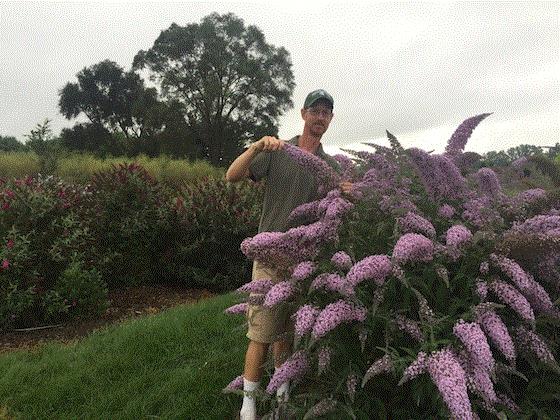
This isn’t your ordinary everyday butterfly bush. Buddleia Grand Cascade from Walters Gardens has enormous 12- to 14-in. long and 4-in. thick panicles. They’re absolutely huge and beautiful. The light lavender purple blooms cascade downward completely covering the 5- to 6-ft. tall bushes in the late summer, giving an appealing weeping appearance. Grand Cascade bred by Hans Hansen (both shown above) is a great Zone 5 plant for attracting pollinators and is an awesome landscape specimen.
Meet Hans Hansen
Speaking of Hans Hansen, I thought I’d try a new segment in the newsletter where I feature some of the breeders behind the plants we all grow and love (and love to grow), and you guessed it, Hans is my proverbial guinea pig, so to speak.
Hans has spent most of his career working with baptisia, lily, hosta and peony, but has also worked extensively with over 70 perennial genera. He’s discovered or stabilized numerous sports, as well as worked with hybridization of many perennials. His introductions to date are impressive and far too numerous to list here. However, I can’t leave you hanging, so here are a few of his most recognizable intros thus far.
|
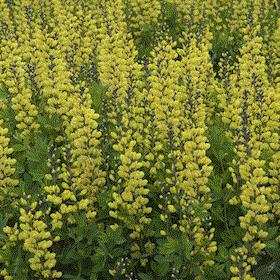
Baptisia Decadence Lemon Meringue
Photo credits: Walters Gardens, Inc.
|
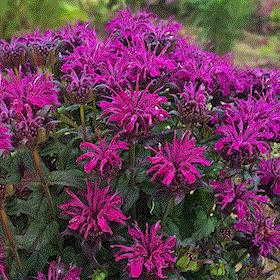
Monarda Sugar Buzz Rockin' Raspberry
|
Of course, you’re already aware of the Buddleia Grand Cascade featured above, but he's also introduced the cultivars in the Humdinger, Cascade and Monarch series of butterfly bushes. Perhaps you’ve heard of the colorful and very reliable Decadence series of baptisia he bred.
You may not have known that Hans has introduced over 60 hosta cultivars, including Fire and Ice, and Touch of Class. Oh my, the list goes on: Achillea Sassy Summer series; Dianthus Fruit Punch and Pretty Poppers series; Monarda Leading Lady and Sugar Buzz series; and Phlox Opening Act series.
And this is just the tip of the iceberg—Hans has also introduced various cultivars of agastache, clematis, digiplexis, helleborus, heuchera, heucherella, hibiscus, lagerstroemia, mangave, nepeta, salvia, sedum and veronica. I think you get the picture ... he’s pretty talented and accomplished to say the least.

Q & A with Hans
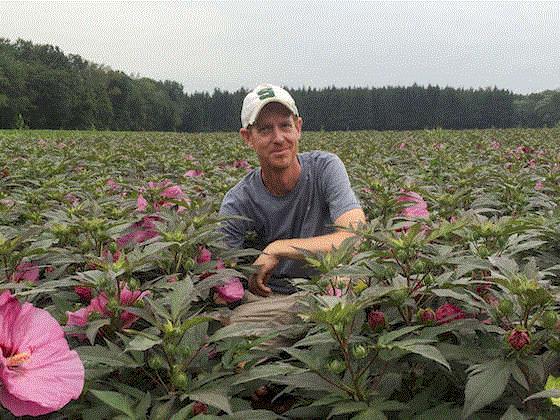
Hans Hansen in a field of his hybrid Hibiscus Berry Awesome.
Now that you know what Hans Hansen has accomplished, I asked him a few questions about his journey and thought I’d share that conversation with you.
|
Paul: |
From my understanding, you discovered your passion for plants at a very young age. Could you tell me more about your first memories or experiences with plants?
|
|
Hans: |
The earliest memory I have is planting onions in the family vegetable garden. I was about 4 years old, my parents gave me a 3-in. stick as a template for spacing and I used it to space onions in a pre-made furrow. I went to garden club meetings as a youngster, always begged for plants for Christmas and birthdays. After joining the North American Lily Society as a teenager, I began hybridizing Asiatic lilies (self-taught from reading journals).
Growing up on a dairy farm, my family let me have space for gardening and collecting plants. Neighbors were generous with encouragement and divisions of iris and other perennials. I’ve always been interested in perennials. My dad instilled hard work, common sense/practicality and a love of the land.
|
|
Paul: |
How did you become interested in breeding?
|
|
Hans: |
Always having a keen interest in growing plants from seed, I checked out and read a book on Luther Burbank when I was in elementary school and knew after reading his story I wanted to hybridize plants. Lilies were my first project; hostas and peonies followed shortly after, as well as herbaceous clematis.
|
|
Paul: |
I know there’s a lot behind the work that you do, and I’m very interested in learning more about what it takes to successfully breed and bring a plant to market. Could you please give me a brief description of the process and how long it takes to breed, select and introduce a plant?
|
|
Hans: |
I begin by brainstorming and determining if there is garden/commercial interest in a project. Most of the breeding projects at Walters Gardens are for plants with great habit (i.e. having more basal branching, flower coverage, certain foliage characteristics, disease-resistant foliage, strong stems, season extenders [earlier or later flowering], good vigor and good performance [in the lab, field, container and at retail]). I try to assemble all the species/hybrids of a genus that have positive characteristics and familiarize myself with them.
The length between making the cross and introducing the plant is dependent on the genera and method of propagation. The average perennial takes about two years from seed germination to make the pre-selections and an additional two years for the comparison trials and performance evaluations. From there, it often takes an additional two years (six years total) if everything goes well (clean bill of health, certified virus free, passed production trials, container trials, good marketable photography, grower notes, etc.) to bring the plant to the wholesale trade.
|
|
Paul: |
What plant did you have the most fun working on?
|
|
Hans: |
Working with Mangave has been the most rewarding project. It’s been interesting to see all the diversity and progress in the last 10 years—shortening the life cycle of the agave, making them more garden and nursery friendly by having a quicker growth rate, fewer spines and more foliage interest (red, purple coloration, spots and variegation). It’s been a huge collaborative effort with many gardeners and friends mailing me pollen from flowering agave plants from their own collections.
|
|
Paul: |
What’s the most bizarre outcome you’ve experienced?
|
|
Hans: |
Probably plants resulting from ploidy elevation. Converting plants from triploid to hexaploid or tets to octaploid produced some pretty interesting non-commercial plants. (Paul: That sounds above my pay grade.)
Perhaps the most bizarre cross was a phlox hybrid between Phlox procumbens and Phlox paniculata. The single seedling from this wide cross exhibited the worst traits from both parents. Scientifically, it was a hybridizers triumph, however, from a gardener’s perspective, it had very few desirable qualities.
|
|
Paul: |
What’s your favorite introduction to date?
|
|
Hans: |
Oh, that’s hard to pick. I really immerse myself into all my projects. For example achillea weren’t on my top 50 list of favorite perennials, but I’m happy with the results of the work we did (interspecifics with incredible foliage, stem strength, bloom time, garden habit and flower color range).
The Mangaves come to mind, Hosta Neptune, Hibiscus Holy Grail, Baptisia Lemon Meringue, Baptisia Sparking Sapphires and Heuchera Black Pearl are also among my favorites.
|
|
Paul: |
Can you tell us what plants or genera you’re working on now?
|
|
Hans: |
Continued work with Mangave—I still believe there is a lot of value for these plants in containers and for landscape use as seasonal color or permanence where they're hardy. Hibiscus—(broaden color range/patterns while maintaining criteria of high-quality garden performance), hostas, kniphofia and agapanthus to name a few.
|
|
Paul: |
Any closing thoughts?
|
|
Hans: |
I’m truly blessed to work in a profession where I absolutely love my work, feel I’m making valuable contributions to the world of horticulture, am surrounded by an incredible team of co-workers, staff, summer interns and mentors, and to be able to work for a company that encourages and fosters new plant development. Walters Gardens is a great fit for me and I am so blessed to be a part of it.
|
Thanks so much for taking the time to answer these questions, Hans! I really appreciate what you do and look forward to seeing the fruits of your labor in the years ahead.
Did you like the inaugural "Meet the Breeder" feature? Would you like to see more breeders featured in future newsletters? If so, please let me know. I’d also be interested in hearing if there are any specific breeders you’d like to learn more about. Email your comments and requests to ppilon@ballpublishing.com.

Cherry Bloom Sedge
Ever find yourself longing for a more colorful sedge. Well, the wait is over. Allow me to introduce Carex scaposa, a new sedge from Hoffman Nursery. With its cherry blossom pink spikes, this bright and showy sedge sets itself apart from the others. This delightful carex has arching deep green blades measuring 1.25-in. wide that gradually narrow towards the tips. The flowers are borne on sturdy scapes (to which the botanical name scaposa refers) in the early spring and again in the early fall. It’s hardy to Zone 6.
The introduction of this shade-tolerant (it actually prefers light shade), colorful sedge to the U.S. is due to the efforts of the U.S. Arboretum Director Dr. Richard Olsen who acquired it from the Kunming Botanical Garden in China. In appreciation for his efforts, Hoffman Nursery will donate 10 cents from every plant sold to the U.S. National Arboretum to help them continue their exploration and conservation efforts. Sounds like a win-win proposition to me. Thank you, Dr. Olsen, for bringing us this great new carex.

Perennial Plants for Every Season
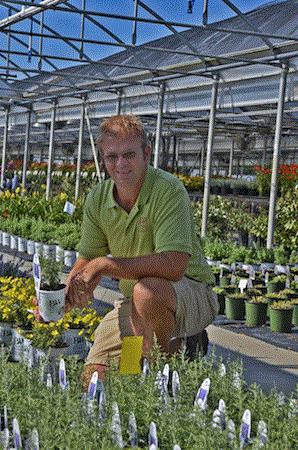
Come join next week’s FREE perennial webinar, titled “Perennial Plants for Every Season – the Right Material at the Right Time.” Walters Gardens Trial Manager Jeremy Windemuller will share his expertise about how some perennials benefit from being grown during the summer months rather than planted in the late winter or spring. Come join Jeremy in this complimentary session to learn which items benefit from summer planting, their cultural requirements and how to overwinter them.
The webinar will be held at 1:00 p.m. Eastern/12:00 p.m. Central time on Wednesday, February, 14, 2018. Click here to learn more and to register for this FREE webinar.
Benchmarking the Industry
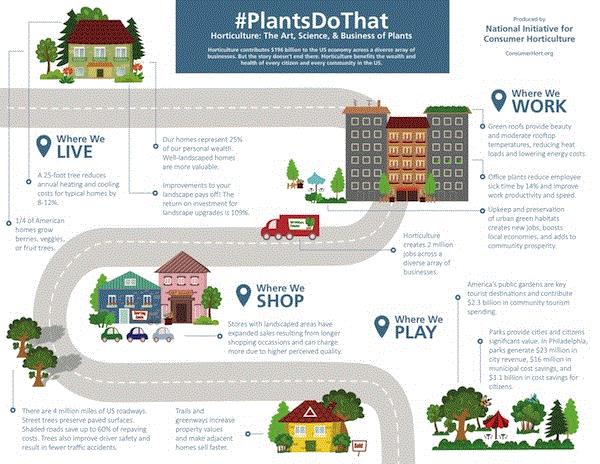
Click on the image to see a larger and easier-to-read copy of the #PlantsDoThat poster.
The National Initiative for Consumer Horticulture (NICH) is asking all businesses and non-profits engaged in horticulture to participate in a brief, three-minute survey to help grow the industry.
Before I get to the survey, I thought I’d give you a brief synopsis of what NICH is and what they do. NICH is a broad coalition representing the entirety of consumer horticulture. Their mission is “Growing a healthy world through plants, gardens and landscapes” and their vision is to increase the percentage of U.S. households participating in Consumer Horticulture to 90% by 2025. One of their aims is to help our industry to get more market share, more profit and more access to federal, state, local and other resources to grow the industry. I know this sounds ambitious and there's more to NICH than I can cover here, so if you’d like to learn more, visit their website: www.consumerhort.org.
Now back to the survey ... The survey’s goal is to collect information to help NICH to better understand the benchmarks and tools being used by the industry to manage their businesses. This information will help them identify what numbers are important to our industry and to identify any gaps where more or different data is needed.
Participating in the NICH Economic Committee Survey will help them position consumer horticulture as the vital segment of agriculture and economy that it is. By understanding the economic data, NICH will identify ways to increase our industry’s access to federal, state and other sources of critical funding. These resources will shape our ability to grow and strengthen horticulture.
Click here to participate in the survey. To read more about NICH, fellow newsletter editor Debbie Hamrick wrote a guest column in the February issue of GrowerTalks.
NICH will be hosting a conference call in June 2018 to discuss the survey results.




Thanks for reading this edition of Perennial Pulse. Please feel free to email me with any article ideas, questions for future newsletters or just to say hello. My email is ppilon@ballpublishing.com.
Paul Pilon
Editor-at-Large
Perennial Pulse
This email was received by you and over 33,499 subscribers!
If you're interested in advertising in Perennial Pulse, contact Kim Brown ASAP and she'll hook you up.